Isabella Bradford's Blog, page 43
January 29, 2017
Still Working, But We'll Be Back Soon
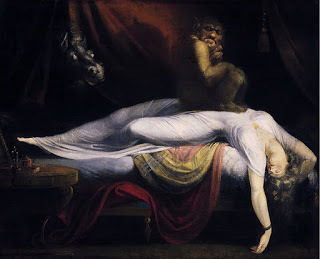 Fuseli, The Nightmare
Loretta & Susan report:
Fuseli, The Nightmare
Loretta & Susan report:No, our books are not yet done, which is why you haven’t seen a blog post in some time.
The good news is, the finish line is in view, even if the view is kind of blurry at the moment—though that might be due to lack of sleep or brain fatigue.
We apologize for the overlong blank stretch—believe us, it hasn’t been a holiday, by any means, and the picture doesn't exaggerate. We thank you for your patience and for all the kind words and positive thoughts you’ve sent our way.
If all goes reasonably well, we’ll return to our regularly scheduled blogging by the second week of February, if not sooner.
Image: John Henry Fuseli, The Nightmare (1781), from the collection of the Detroit Institute of Arts
Clicking on the image will enlarge it. Clicking on the caption will take you to the source, where you can learn more and enlarge images as needed.
Published on January 29, 2017 13:00
January 9, 2017
Fashions for January 1801
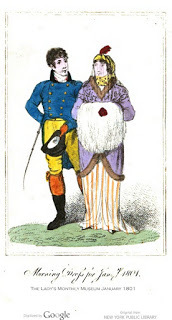 Morning Dress 1801
Loretta reports:
Morning Dress 1801
Loretta reports:We’ll kick off the 2017 monthly fashion plates by returning to the beginning of the 19th century—and incidentally get a lesson in differences in digitization technology. The first plates and the description are from a Google scan of the New York Public Library’s copy of The Lady’s Monthly Museum for January 1801. They look like the work of an inept artist, don’t they?
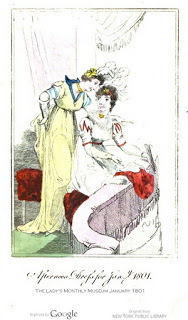 Afternoon Dress 1801
Afternoon Dress 1801
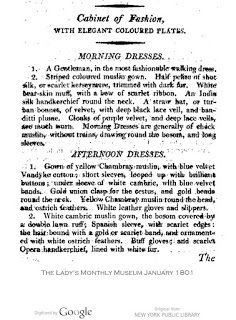 Now let's look at the last image, which came from the Los Angeles County Museum of Art’s online collection. This is the same “Afternoon Dress” fashion plate as above, but what a difference! (Unfortunately, I haven’t been able to find a high quality counterpart to the Morning Dress plate.)
Now let's look at the last image, which came from the Los Angeles County Museum of Art’s online collection. This is the same “Afternoon Dress” fashion plate as above, but what a difference! (Unfortunately, I haven’t been able to find a high quality counterpart to the Morning Dress plate.)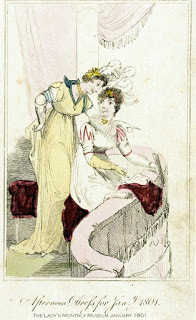 Afternoon Dress
Many libraries have fine images like this of fashion plates. The trouble is, in most cases—as I’ve complained repeatedly—all we have is the plate. The rest of the magazine, including the description, is who knows where.
Afternoon Dress
Many libraries have fine images like this of fashion plates. The trouble is, in most cases—as I’ve complained repeatedly—all we have is the plate. The rest of the magazine, including the description, is who knows where.Let's hope that the magazines Google digitized in the early days haven't been destroyed, and will one day be re-scanned using improved technology.
Images, from The Lady’s Monthly Museum Vol 6 Jan-June 1801 courtesy Hathi Trust. Second Afternoon Dress image courtesy Los Angeles County Museum of Art.
Clicking on the image will enlarge it. Clicking on the caption will take you to the source, where you can learn more and enlarge images as needed.
Published on January 09, 2017 21:30
December 12, 2016
Tuesday Video: A Holiday Story of 1912
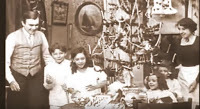
Loretta & Isabella report:
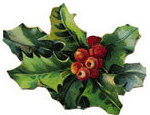 Impending deadlines (which you’ve heard about more than once here) oblige us to start our holiday break a little earlier than usual. But we promise to be back in 2017 with more Nerdy History stuff. If you get too lonely for old things, in the meantime, please do search our archives. You might be surprised. We are, sometimes, when we look there—and realize we’ve accumulated seven years of material!
Impending deadlines (which you’ve heard about more than once here) oblige us to start our holiday break a little earlier than usual. But we promise to be back in 2017 with more Nerdy History stuff. If you get too lonely for old things, in the meantime, please do search our archives. You might be surprised. We are, sometimes, when we look there—and realize we’ve accumulated seven years of material!Thank you for encouraging us to carry on for all this time, digging up this and that from the past.
We wish you a happy and hopeful holiday season, rather in the spirit of today’s video. A Christmas Accident (1912),* by director-actor-writer Harold M. Shaw, is a Christmas Carol type of story told without the ghosts. It’s sentimental, but we think the sentiments hold up nicely over time.
Credits: Youtube source: A Christmas Accident -1912-Harold M. Shaw- A charming surprise-An old Christmas story. *Also part of a DVD collection, Christmas Past . Image is a still from the film
Readers who receive our blog via email might see a rectangle, square, or nothing where the video ought to be. To watch the video, please click on the title to this post.
Published on December 12, 2016 21:30
December 11, 2016
A Dinner Dress for the Holidays, c1824-26
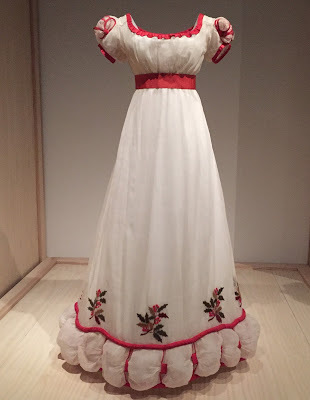 Isabella reporting,
Isabella reporting,I recently visited the Masterworks: Unpacking Fashion exhibition currently on display in the Costume Institute of the Metropolitan Museum of Art. They're not kidding about that title, either: every garment truly is a masterwork, and in exquisite condition. It's an amazing exhibition, and if you're fortunate enough to be in New York, it's definitely worth a trip to the Met.
With the Christmas holidays just around the corner, this dress from the exhibition seems particularly appropriate to share. This dress is simply fun, and it made everyone who came around the gallery corner smile.

It's also wonderful to see a dress like this in person. As Loretta has pointed out in other blogs featuring fashion plates from this era ( here , here , and here ), imagining exactly how the elaborate trimmings must have looked isn't easy. The detailed embellishments of this dress - poufs, red silk stuffed cording, and polychrome wool embroidery - add wonderful color and dimension to an otherwise plain white dress. (Loretta and I also marveled at how the wearer managed to keep a snow-white dinner dress so perfectly clean, without a single spot of gravy or spilled claret-cup - though that may be revealing more about us at Christmas parties than the unknown wearer.)
The museum's information is worth repeating here:
"Fashionable British dress from the early decades of the nineteenth century reveals a fascination with historical styles. Drawing inspiration from literature, theater costumes and history paintings of medieval and Renaissance subjects, dressmakers incorporated stylistic details from twelfth-through seventeenth-century dress into contemporary fashions. The decoratively slashed sleeves of the sixteenth century, through which linen undershirts were loosely drawn, inspired puffed trimmings such as the bouillons of fine white lawn that encircle the hem of this 1820s dress. Historicized elements such as these reflect a nostalgia for Britain's past, evoking romantic notions of the chivalry or patriotism of earlier eras. The wool crewel-embroidered holly boughs at the hem indicate that the dress was worn in winter, when the plant's berries and foliage provided welcome color and featured prominently in Christmas decorations."
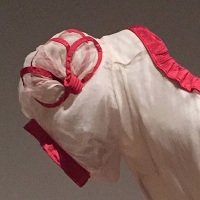
When I shared this dress on Instagram, readers wondered how the wearer could have kept warm, wearing a short-sleeved cotton dress in December in houses without central heating. The answer: a luxurious cashmere shawl (see here and here .)
Above: Dinner Dress, maker unknown, British, 1824-26. White cotton lawn embroidered with holly motifs in red and green wool, trimmed with red silk taffeta. Metropolitan Museum of Art. Photographs ©2016 Susan Holloway Scott.
Published on December 11, 2016 17:00
December 10, 2016
Breakfast Links: Week of December 5, 2016
 Breakfast Links are served - our weekly round-up of fav links to other web sites, articles, blogs, and images via Twitter.
Breakfast Links are served - our weekly round-up of fav links to other web sites, articles, blogs, and images via Twitter.• Restoring an ethereal Tiffany mosaic in a Bronx cemetery.
• For Hamilton fans: Unsullied by falsehood: no John Trumbull .
• A hairy subject: secrecy, shame, and Victorian wigs .
• The scandalous love triangle of Maria Foote, William Berkeley, and Joseph "Pea Green" Hayne.
• How two different museums archive and display American fashion .
• Image: Best typo excuse ever, 18thc style.
• Bake this 17thc recipe for " carraway bunns " from the collection of the Folger Library.
• Where did Jane Austen's characterizations of the clergy come from?
• Annie Jenness Miller , New Hampshire's 19thc dress reformer.
• Debunking the myth that people married very young in "the olden days."
• Inside the textile conservation studio of National Museums Scotland: looking for the mermaid's tail.
• The headstone and lost history of Louise the Unfortunate .
• Image: Tiny (very tiny) 19thc books and playing cards.
• The marriage bond for William Shakespeare and Anne Hathaway.
• Extreme shipping: when express delivery to California meant 100 grueling days at sea.
• Why wild turkeys hate the wild.
• 2,000 year old pet cats discovered in a Roman burial ground in Egypt.
• The Mother Bethel African Methodist Episcopal Church in Philadelphia stands on the oldest parcel of land continuously owned by African Americans in America.
• Holocaust jacket found at a tag sale.
• Image: Mason's " mark " spotted on modern window replacement at Gloucester Cathedral.
• Having a grand old time in a 1920s real-life Westworld.
• Pierre Andre Latreille: how a beetle saved an imprisoned entomologist from the guillotine.
• Jamestown's relics : sacred presence in the English New World.
• How a Victorian parlour stool relates to modern dental stools.
• "We have conquered pain": uses and abuses of ether through history.
• Image: In 1881, the American satirical magazine Puck introduced the first emoticons .
Hungry for more? Follow us on Twitter @2nerdyhistgirls for fresh updates daily.
Above: At Breakfast by Laurits Andersen Ring. Private collection
Published on December 10, 2016 14:00
December 8, 2016
Friday Video: Early Erotica? A Victorian Woman Undresses, 1896
Isabella reporting,
This super-short film (a little over a minute) has been popular on social media recently, and for good reason, too. For modern costume historians, it's the perfect way to see all the layers of clothing an Englishwoman wore in 1896 - and how quickly she could remove those layers, too.
But documenting a woman's wardrobe wasn't the original point of this film. Here's the information supplied by the British Film Institute:
"Is this Britain's oldest erotic film? Modern viewers might question how genuinely erotic it is. But it certainly pushed the boundaries of what was permissible in 1896 - and there's little doubt that it was intended to titillate. Erotica being what it is, it's possible that other (and perhaps more explicit) examples exist in private hands, but this is certainly the oldest surviving British film of its kind that we know of.
"Also known as A Woman Undressing, the film is credited to Brighton-based pioneer Esmé Collings _ making it one of very few of his films to survive. Alongside rather more demure films from around the same time, such as Grandma's Reading Glass (1900) and As Seen Through a Telescope (1900), it demonstrates that early filmmakers - even in these comparatively inhibited islands - were quick to realize the new medium's implicit voyeurism."
Victorian Lady in Her Boudoir by Esmé Collings, 1896, BFI.
Published on December 08, 2016 21:00
Friday Video: A Victorian Lady Undresses, 1896
Isabella reporting,
This super-short film (a little over a minute) has been popular on social media recently, and for good reason, too. For modern costume historians, it's the perfect way to see all the layers of clothing an Englishwoman wore in 1896 - and how quickly she could remove those layers, too.
But documenting a woman's wardrobe wasn't the original point of this film. Here's the information supplied by the British Film Institute:
"Is this Britain's oldest erotic film? Modern viewers might question how genuinely erotic it is. But it certainly pushed the boundaries of what was permissible in 1896 - and there's little doubt that it was intended to titillate. Erotica being what it is, it's possible that other (and perhaps more explicit) examples exist in private hands, but this is certainly the oldest surviving British film of its kind that we know of.
"Also known as A Woman Undressing, the film is credited to Brighton-based pioneer Esmé Collings _ making it one of very few of his films to survive. Alongside rather more demure films from around the same time, such as Grandma's Reading Glass (1900) and As Seen Through a Telescope (1900), it demonstrates that early filmmakers - even in these comparatively inhibited islands - were quick to realize the new medium's implicit voyeurism."
Victorian Lady in Her Boudoir by Esmé Collings, 1896, BFI.
Published on December 08, 2016 21:00
December 7, 2016
A Cabinet (of Curiosities?) for December 1828
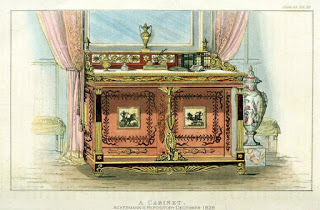 1828 Cabinet
1828 Cabinet
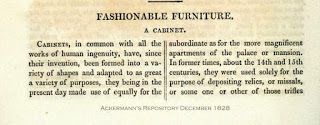 1828 Cabinet description
Loretta reports:
1828 Cabinet description
Loretta reports:As we’ve seen, a great deal of Regency and Romantic era design does not operate on the principle of Less is More. This cabinet is a fine example of the Decorated-Within-An-Inch-of-Its-Life mode. It’s also the kind of piece I might find myself using in a scene: the little drawers and pigeonholes, the objects sitting on top, and who knows what below, behind the doors …
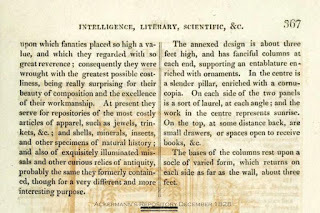 1828 Cabinet Description
1828 Cabinet Description
Clicking on the image will enlarge it. Clicking on the caption will take you to the source, where you can learn more and enlarge images as needed.
Published on December 07, 2016 21:30
December 5, 2016
The Extraordinary Style of the Countess Greffulhe
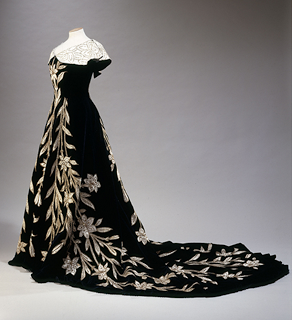 Isabella reporting,
Isabella reporting,French women have always had a reputation for being fashionable, but Élisabeth de Caraman-Chimay, the Countess Greffulhe (1860-1952) made fashion into an opulent gesture of self-expression. While she was known as a patroness of artists, writers, and musicians and as a hostess whose salons attracted the most brilliant members of European society, it is her sense of style that makes her so memorable today.
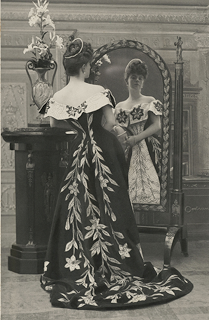
There are two reasons for this. First, she was immortalized as the fictionalized Oriane, Duchesse de Guermantes, in the famous novel À la recherche du temps perdu by Marcel Proust. Second, her family preserved much of her famous wardrobe. The highlights of this collection are currently on display in the exhibition Proust's Muse: The Countess Greffulhe at the Museum at FIT in New York City through January 7, 2017. (Many of the pieces appeared first in an earlier exhibition organized by the Palais Galleria, Musée de la Ville de Paris, the permanent repository of the Countess's wardrobe.)
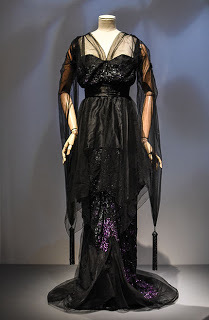 It's an amazing show. The earliest pieces date from 1887, when the Countess was a teen-aged newlywed. Already her taste - and her daring - are on display. There's a sleeveless, black lace bodice that would have been worn over a colored gown, not-so-subtle transparency that must have been shocking at the time.
It's an amazing show. The earliest pieces date from 1887, when the Countess was a teen-aged newlywed. Already her taste - and her daring - are on display. There's a sleeveless, black lace bodice that would have been worn over a colored gown, not-so-subtle transparency that must have been shocking at the time.By the later 1890s, the Countess was not only commissioning clothing from premier couturiers like the House of Worth, but collaborating with them, pushing the designers to create the dramatic clothing she craved. She loved to be the center of attention wherever she went, and journalists devoted countless words to describing what she wore to the opera or theatre. She posed for photographers like Paul Nadar, and polished her "image" before that very-modern sense of the word existed.
One of her most famous dresses by Worth, above left, was known as the "lily dress" for its bold black-and-white embroidered design. The photograph, above right, shows the Countess wearing the dress, with her pose carefully staged with the mirror to display both the dress, and her own beauty.
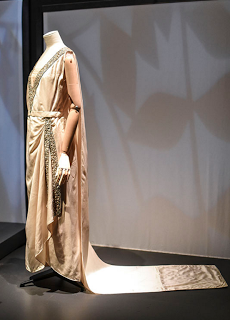
To me perhaps the most extraordinary thing about the exhibition is that it includes clothes worn by the Countess throughout her long life, from the heavily corseted dresses of the Belle Epoque to the narrower silhouette of the early 1910s, lower left, to straight, beaded shifts of the 1920s, lower right, to the beautifully cut and sinuous dresses and suits of the 1930s. Certain elements of her taste (for example, she frequently wore the color green, flattering to her auburn hair, and she loved exotic Byzantine prints and motifs) remain, weaving in and out of the changing fashions. Yet always her clothes remained constant to who she was, and how she wished to be seen - and remembered.
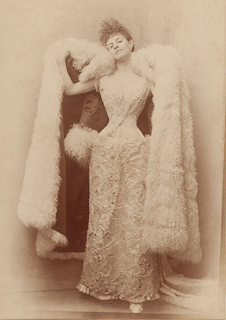
Unfortunately the Musée de la Ville de Paris prohibited visitor photography. You can see more of the Countess's dresses here , on the the exhibition's blog, and on the museum's Flickr account here .
Many thanks to Nicole Bloomfield, Costume & Textile Conservator, and Ariele Elia, Assistant Curator of Costume & Textile, Museum at FIT, for their help with this post.
Upper left: Evening gown, known as "La Robe aux Lis" (the lily dress) c1896, by House of Worth. Photograph by L. Degraces et Ph.Joffre/Galliera/roger-Viollet.
Upper right: The Countess Greffulhe by Paul Nadar, c1896.
Lower left: Evening dress, c1913, by Pierre Bulloz. Photograph ©Zach Hilty/BFA.com
Lower right: Evening dress, c1925, by Jenny. Photograph ©Zach Hilty/BFA.com.
Bottom left: The Countess Greffulhe in a Ballgown by Otto Wegener, c1887.
All images from Palais Galliera, Musee de la mode de la Ville de Paris.
Published on December 05, 2016 21:00
December 4, 2016
Holiday Gift Ideas for 1913
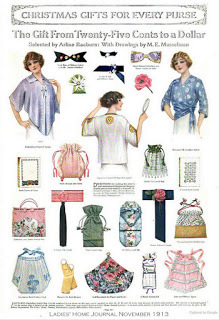 Gifts for 1913
Gifts for 1913
Loretta reports:
Instead of a fashion plate for the 1910s (yes, we’ve come that far in the year’s survey), I’m presenting a few pages of the Ladies' Home Journal holiday gift ideas from their November 1913 issue.
I don’t know about you, but I wouldn’t mind receiving some of these myself!
If you’re desperately missing the monthly fashion plate, here’s one from the December 1913 Delineator , with several more pages of fashion following.
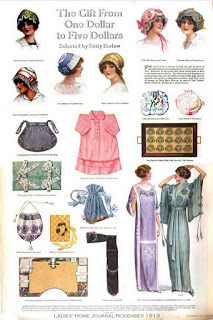 Gifts for 1913
Gifts for 1913
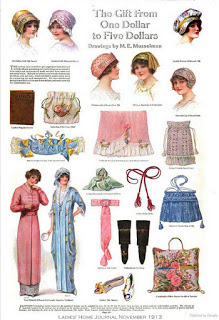 Gifts for 1913
Gifts for 1913
Published on December 04, 2016 21:30



